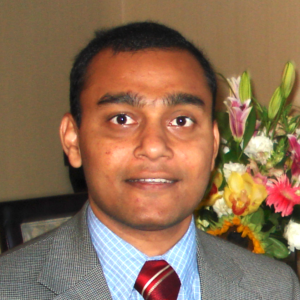
Hugo Aerts, Ph.D.
Medical Need
In established radiologic practice, trained physicians visually assess medical images for diagnosis, treatment planning, and response assessment. Novel deep learning algorithms have demonstrated unprecedented success in image recognition that has led to applications in radiographic image analysis that are propelling the field forward at a rapid pace. AI methods excel in recognizing complex patterns in imaging data and provide quantitative, rather than qualitative, assessment of radiographic features that can assist physicians in improving clinical workflow and making more accurate and reproducible radiologic assessment.
Current Research
- Developing advanced A.I. technologies applied to Radiology data.
- We investigate the role of radiologic A.I. for precision medicine for several clinical problems.
More at: www.cibl-harvard.org and www.radiomics.io

Andriy Y. Fedorov, Ph.D.
Medical Need
Quantitative imaging (QI) and medical image computing attracted strong interest of the research community in the recent decades. Nevertheless, the growth in development and adoption of the advanced analysis tools and imaging biomarkers lags behind the rate of the innovative ideas being proposed in the academic literature. I consider the lack of sharing of the analysis results and tools as a key obstacle for scientific innovation. I develop infrastructure to help scientist meaningfully share their analysis results and tools, and apply these principles in my own research in quantitative imaging biomarker development and image-guided therapy.
Current Research
1. Quantitative Image Informatics for Cancer Research (QIICR): leading development of standards-based open source sharing of QI analysis data and tools.
2. Prostate project of the National Center for Image Guided Therapy (NCIGT): technical lead for the development of the open source informatics platform .
3. Radiomics platform and applications development: I am contributing to the development of the open source infrastructure for radiomics research.
More at http://fedorov.github.io

Michael Halle, Ph.D.
Medical Need
Liver transplant is currently the only cure for cirrhosis. Liver transplant teams must identify the patients who most urgently need transplantation but who are also well enough to survive the procedure. Today, prioritization for liver transplant uses a score called MELD that is based on blood tests. However, a patient’s MELD score may fail to fully capture potentially life-threatening symptoms of cirrhosis such as a risk for internal bleeding (varices) or devastating infection (ascites).
Current Research
Dr. Halle’s multi-disciplinary team of doctors, computer scientists, radiologists and hepatologists are using artificial intelligence methods to discover patterns of liver disease hidden in a patient’s magnetic resonance imaging (MRI) scans. By comparing image features collected from the scans of hundreds of patients both with and without cirrhosis, they’ll identify characteristic patterns of the disease symptoms and correlate them with the patients’ MELD scores and clinical observations to produce a better, more comprehensive measure of liver disease.

Ron Kikinis, M.D.
Medical Need
Medical imaging offers a wealth of information about an individual patient’s health, both at the time of visit and into the future. New imaging technologies offer more and better data, and are now essential for both treatment planning and intraoperative procedures. Extracting quantitative information from medical image data is essential in order to integrate imaging with patient history, laboratory tests and genomic information to form a complete view of a patient’s health. Information inside patient scans must be searchable in order to pinpoint clues about disease and to find similarities across patients.
Current Research
- Leading development of 3D Slicer, a global, open, community-driven software platform for medical image computing and analysis. ( https://www.slicer.org/wiki/Main_Page/SlicerCommunity ).
- Developing algorithms to extract features from medical images that can be searched and correlated as part of a patient record.
- Integrating medical imaging techniques with algorithms to address patient-specific and treatment-specific needs in surgery.
- Cooperation with medical imaging and device vendors to promote interoperability and data exchange.
More at: http://www.spl.harvard.edu/

Lauren J. O’Donnell, Ph.D.
Medical Need
Functional MRI (fMRI) and diffusion MRI (dMRI) provide non-invasive maps of functional activations and white matter connections in the human brain. In neurosurgical patients, fMRI and dMRI can increase tumor resection and patient survival, but interpretation of the data is difficult, requiring extensive experience and time, and limiting the deployment of these modalities. Computational approaches based on newly available large-scale imaging datasets have the potential to improve neurosurgical planning by identifying crucial patient-specific neuroanatomy.
Current Research
- We are investigating machine-learning-based multimodal structure-function brain models that can generalize to neurosurgical patients to aid surgical planning.
- We are developing open-source software for diffusion MRI analysis and visualization with applications to brain cancer research.
- We are developing data-driven computational methods for analysis and modeling of white matter connections in large datasets, with applications in studies of neuroanatomy, brain injury, and psychiatry.

Yogesh Rathi, Ph.D.
Medical Need
Deep brain stimulation (DBS) and transcranial magnetic stimulation (TMS) are increasingly being used to treat neurological and neuropsychiatric disorders such as Parkinson’s disease, major depression, schizophrenia etc. An important problem to be addressed is: How to precisely place the DBS electrodes or use TMS for maximum treatment efficacy in a subject-specific manner.
Current Research
- We are developing a personalized and anatomically informed, diffusion MRI based tractography guided system for accurate placement of DBS electrodes.
- We are developing methods that will provide best cortical stimulation targets based on diffusion and functional MRI data in a subject specific manner.
- We are developing new mathematical models and biomarkers that can predict who will respond to DBS/TMS therapy.

Clare Tempany-Afdhal, M.D.
Medical Need
Dr. Tempany leads the The National Center for Image Guided Therapy (NCIGT), located at Brigham and Women’s Hospital and Harvard Medical School in Boston. NCIGT is a Biomedical Technology Resource Center funded by the National Institute of Biomedical Imaging and Bioengineering which serves as a national resource for all aspects of research into medical procedures enhanced by imaging, with the common goal of providing more effective patient care.
Dr. Tempany is particulary involved in the Prostate Project. There are two complex issues that drive the clinical need to change current paradigms for prostate cancer (PCa): The inability to predict aggressiveness of a given cancer, which in turn leads to over treatment, and the increasing evidence that disease progression in men with seemingly low-risk PCa is due to inadequate biopsy sampling. Technical solutions to address these challenges, and their validation in clinic, are lacking.
Current Research
- We are working to address these challenges by integrating innovative MR image acquisition and analysis with the MR targeted biopsy platform.
- We are developing a diagnostic biomedical imaging platform to detect, characterize and diagnose prostate cancer and will provide new opportunities to understand the aggressiveness and heterogeneity of prostate cancer and ultimately allow for development and testing of new predictive markers in focal therapy.


